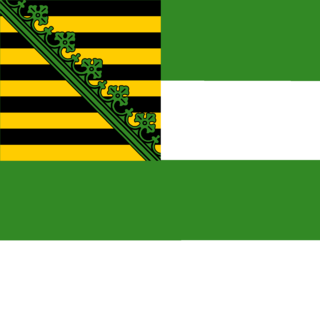
The Mellrichstadt–Fladungen railway, also called the Streu Valley Line, is a Bavarian branch line that connects Mellrichstadt in Lower Franconia with the town of Fladungen, which nestles in the Rhön mountains.

The Schweinfurt–Meiningen railway, route number 5240, is a single-tracked main line in the states of Bavaria and Saxony in southern Germany. It is also called the Main-Rhön-Bahn and is listed in the Deutsche Bahn timetable as route (Kursbuchstrecke) 815. The railway has been part of the Erfurt–Schweinfurt route since 1993. Passenger services on the line are provided by DB Regio and the Erfurter Bahn (EB).
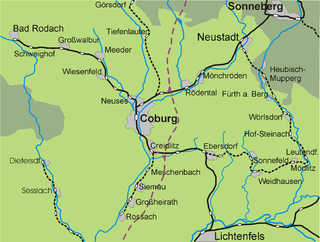
There are six railway stations in the town of Coburg in Bavaria, southern Germany. These include: two passenger stations, three halts and one goods station.

The Thuringian states refers to the following German federal states within the German Reich:

The Eisenach–Lichtenfels railway is a single-tracked main line with a standard gauge of 1,435 mm in Thuringia and Bavaria in southern and central Germany, that runs mostly along the river Werra. It runs from Eisenach via Meiningen to Eisfeld and, formerly, continued to Coburg and Lichtenfels. It was opened in 1858 and is one of the oldest railways in Germany. The railway company that built it, the Werra Eisenbahngesellschaft with its headquarters in Meiningen was also often called the Werrabahn. The company also ran various lines branching off the Werra Railway.

The Itz Valley Railway was a former, 8 kilometre long branch line in Bavaria, Germany, running from Creidlitz, in the borough of Coburg, to Rossach in the municipality of Großheirath.

The Gotha–Leinefelde railway connects Gotha and Leinefelde in the German state of Thuringia. It was opened in 1870 by the Thuringian Railway Company. The line is about 67.1 km long. Regional-Express line 612 services operate every two hours on the line between Göttingen and Chemnitz and Zwickau. Erfurter Bahn operates services every two hours using Regio-Shuttle diesel multiple units. The running time is 40 minutes (Regional-Express) and 65 minutes each way. It is thus part of the fastest connection from Jena, Weimar and Erfurt to Hanover.
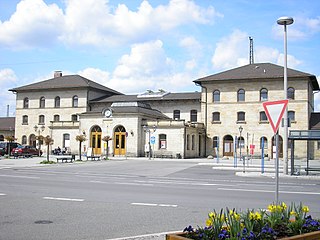
Lichtenfels station is in the town of Lichtenfels in Upper Franconia in the German state of Bavaria. It is a regional rail hub and a former ICE stop on the Hamburg–Berlin Munich route and is classified by Deutsche Bahn as a station of category 3.

Sonneberg Hauptbahnhof is a railway station for the city of Sonneberg in the German state of Thuringia and is on the Coburg–Sonneberg line. The station was built as part of the construction of the Hinterland Railway and still plays a central role in public transport of Sonneberg and the surrounding area. It was built in 1907 to replace the old station, which was built in 1857 and 1858 by the Werra Railway Company, together with the single-track Coburg–Sonneberg line, a branch line of the Werra Railway.
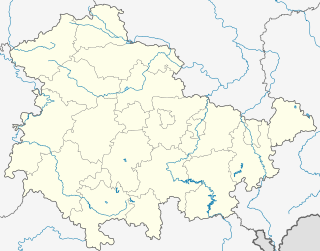
Eisenach Station is the main station of the city of Eisenach in the German state of Thuringia. It is a transportation hub, located on the Thuringian Railway (Berlin/Dresden–) Halle–Bebra and at the Werra Railway (Eisenach–Meiningen–Eisfeld).

Probstzella station is the station of the Thuringian town of Probstzella in the district of Saalfeld-Rudolstadt. It is located at the southeastern edge of Probstzella and since 1 October 1885 it has been a through station on the Franconian Forest Railway. The station is 1.3 km from the Bavarian-Thuringian border and after the Second World War until German reunification in 1990, it served as the point of entry for traffic passing from West Germany to East Germany and is considered the last remaining border station on the Inner German border.

Meiningen station is a junction of four railways and with its facilities is one of the most important railway stations in southern Thuringia, Germany.

The Neudietendorf–Ritschenhausen railway connects Neudietendorf and Ritschenhausen in the German state of Thuringia. It is a mainly single-track main line operated by DB Netze.

The Lichte (Thuringia) east station was a Deutsche Reichsbahn station of the Thuringian municipality of Lichte (Wallendorf) in the district of Saalfeld-Rudolstadt.

Bad Schandau station is a minor junction station in Bad Schandau in the German state of Saxony. The station is located on the south bank on the Elbe on the Děčín–Dresden-Neustadt railway and it is also the terminus of the Bautzen–Bad Schandau railway. The town is located on the north side of the river and is connected to the station by a ferry and a road bridge.

The Lübeck–Puttgarden railway is part of the international Vogelfluglinie between Germany and Denmark and connects Lübeck with Puttgarden on the Baltic Sea island of Fehmarn in the German state of Schleswig-Holstein.

Itzgründisch is a Main Franconian dialect, which is spoken in the eponymous Itz Valley and its tributaries of Grümpen, Effelder, Röthen/Röden, Lauter, Füllbach and Rodach, the valleys of the Neubrunn, Biber and the upper Werra and in the valley of Steinach. In the small language area, which extends from the Itzgrund in Upper Franconia to the southern side of the Thuringian Highlands, “Fränkische” still exists in the original form. Because of the remoteness of the area, this isolated by the end of the 19th century and later during the division of Germany, this language has kept many linguistic features to this day. Scientific study of the Itzgründisch dialect was made for the first time, in the middle of the 19th century, by the linguist August Schleicher.
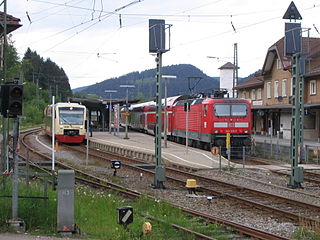
Neustadt (Schwarzw) station is one of two stations in Titisee-Neustadt in the German state of Baden-Württemberg. The other is Titisee. It is located in Neustadt at 805 metres above sea level on the Höllentalbahn, which links Freiburg with Donaueschingen. The station has three platform tracks and is classified by Deutsche Bahn (DB) as a category 5 station. Established in 1887, the entrance building is now heritage-listed and houses among other things a DB agency with ticket sales.

Bad Salzungen station is the station of the town of Bad Salzungen in the German state of Thuringia. It is located on the Werra Railway and on the Werra Valley Railway.






